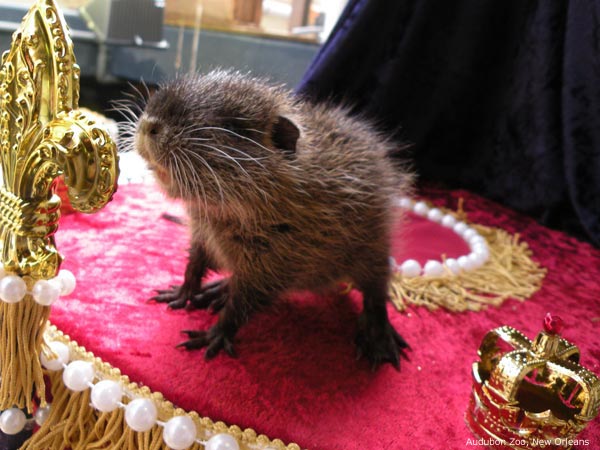Groundhog Alternates Step Up to Predict Spring

Editor's Note: Mixed news from Louisiana this morning (Feb. 2): Pierre Shadeaux saw his shadow, indicating six more weeks of winter, while T-Boy did not, meaning spring for New Orleans is just around the corner. (Cold, overcast weather forced T-Boy's ceremony indoors.)
Move over, weather forecasters and groundhogs — there are other species who can predict the arrival of spring.
This Wednesday (Feb. 2) on Groundhog Day, hours after the renown and eternally young groundhog Punxsutawney Phil looks for his shadow in Pennsylvania, T-Boy will emerge from a hole at the Louisiana Swamp Exhibit at the Audubon Zoo to make his own prediction about the arrival of spring in New Orleans.
T-Boy is a nutria, a type of semiaquatic rodent well-known in this part of the country for damaging the wetlands with its feeding habits. At 6 weeks old, T-Boy, whose name is equivalent to "little boy" among Cajuns, is still in a photogenic phase.
"If you could keep nutrias little, you could create a market for them in the pet trade," said Sarah Burnette, spokeswoman for the Audubon Nature Institute in New Orleans.
But the fluffy babies grow up to sport large orange teeth and other less-appealing features.
"The tail doesn't bother me, but the tail seems to be the thing that everybody else recoils from because it's like a rat tail," Burnette said.
Get the world’s most fascinating discoveries delivered straight to your inbox.
It's not the most obvious substitution. In Pennsylvania, where the folklore of German settlers became the celebration that now grips Punxsutawney, groundhogs emerge from their burrows in early February, although hibernation doesn't fully end for at least another month. Groundhogs are native to North America, with a range that extends south to northern Alabama. As the legend goes, if a groundhog sees its shadow when it emerges on Feb. 2, then winter will last six more weeks. If not, spring is on its way. Turns out, Phil's predictions aren't so accurate. [The History, Hibernation and Folklore Behind Groundhog Day]
Nutria, meanwhile, arrived by way of South America as future fur coats, and they are blamed for destroying the wetlands of the Gulf by grazing their way through the plants that hold the fragile landscape in place. In the 1930s, nutria were released or escaped into the Louisiana marshes from fur farms. Trapping for fur helped bring their population under control for a time, but, in the mid-1980s, the international fur market shrank, trapping declined and nutria proliferated. Since then, more creative techniques have been employed.
Starting in 1995 through the mid-2000s, Sheriff Harry Lee of Jefferson Parish sent out SWAT team snipers to shoot them, and the animals have been promoted as food with recipes like Heart Healthy 'Crock-Pot' Nutria. The Coastwide Nutria Control Program takes a more tried-and-true approach, offering money for tails – proof that an animal was caught.
In its 2009-2010 year, the program, which is run by the Louisiana Department of Wildlife and Fisheries, received 445,963 tails worth $2.2 million in incentive payments. It estimated the animals had damaged 8,475 coastal acres (3,430 hectares) that year.
The swamp exhibit explains the story of the nutria, but the Groundhog Day celebration is just for fun, Brunette said.
However, T-Boy isn't the only nutria stepping into the limelight on Wednesday morning. The Louisiana town of New Iberia has its own "Cajun Groundhog," dubbed Pierre C. Shadeaux, which will emerge from its miniature Acadian-style house in search of his shadow. The furry guy is part of a ceremony similar to Groundhog Day previewed in the local paper, The Daily Iberian.
"Remember here, it's not about winter. That's why we pay no attention to that Yankee groundhog and got our own Cajun groundhog. Winter's not a big deal here, but summer definitely is," Will Chapman, the paper's publisher wrote in a column that appeared online Jan. 28. "Like up north, seeing a shadow is bad news. For them it means six more weeks of winter, but for us it means a shorter spring and a quicker return of summer's heat and humidity."
Edmond Mouton, a biologist who manages the Coastwide Nutria Control Program, has helped catch the nutria that play Pierre Shadeaux – a name that evokes the French origins of Cajuns – and he sees a direct benefit to the nutria control program.
"Of course it's fun, but by the same token it does create some type of interest and awareness with the younger crowd," Mouton told LiveScience. "Subsequent to Groundhog Day, we get lots of inquiries from elementary schools for speakers."
A lack of groundhogs has lead to other unlikely substitutes.
At the Houston Zoo, Penelope and Olivia, two Guinea hogs, a rare breed of pig, are expected to make a weather prediction by choosing between a blue ball – representing six more weeks of winter – and a beach ball – representing an early spring.
- Top 10 Animal Senses Humans Don't Have
- 10 Amazing Things You Didn't Know About Animals
- The Most Popular Myths in Science
You can follow LiveScience senior writer Wynne Parry on Twitter @Wynne_Parry.



